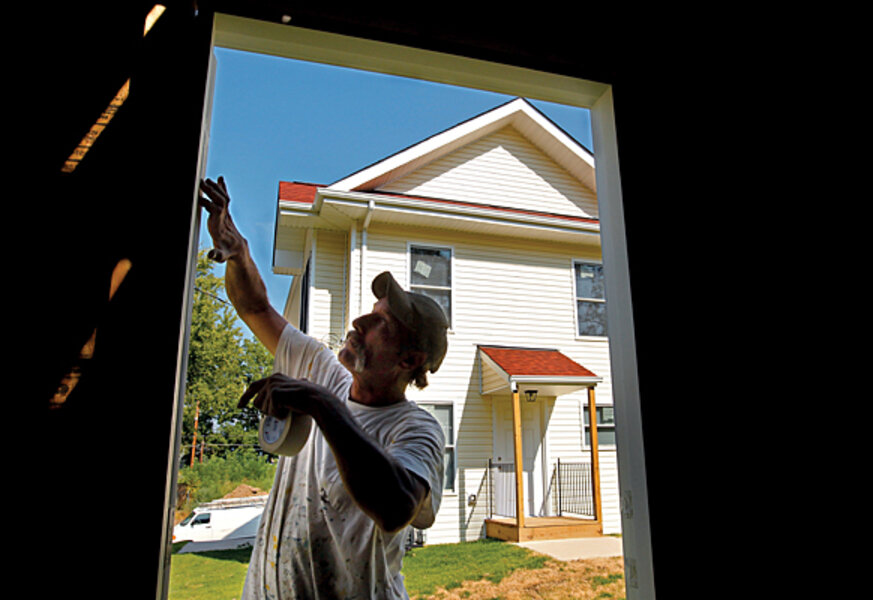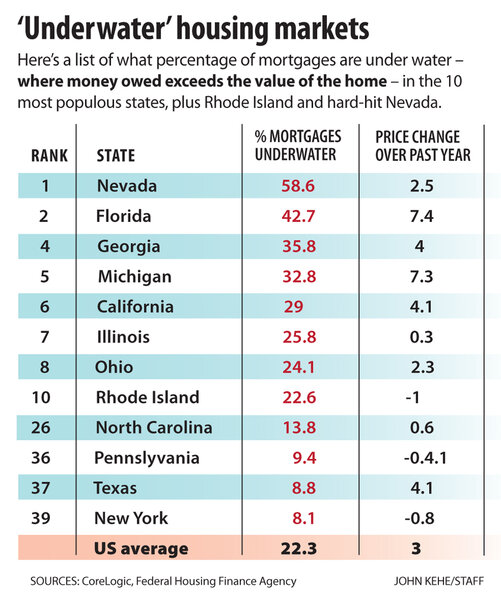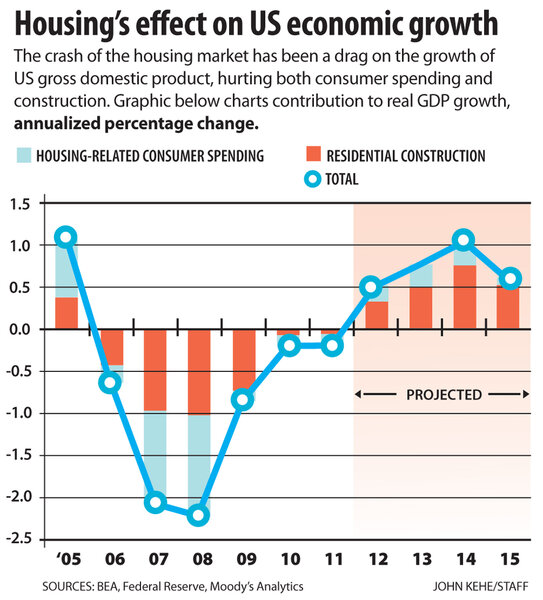Housing market turning a corner? Signs of hope for homeowners.
Loading...
| Providence, R.I.
Here in Rhode Island, some of the best and worst of the US housing market is on display. A price map shows some ZIP Codes around Providence shifting from red (declining) to green (rising). The tally of homes in foreclosure has been falling over the past year. And although the construction industry hasn't decisively turned a corner, some glimmers suggest that brighter days are on the horizon.
After several years of lower-than-usual attendance, the annual clambake of the Rhode Island Builders Association saw turnout nearly double last month.
Indicators like that are visible across much of the nation. Market analysts say the signs of a long-awaited recovery are unmistakable. But as the real estate market enters a cooler season of the year, Rhode Island is also a reminder of the challenges that remain.
A weak economy has pushed more people to rent rather than own. Rental prices have been rising. And even though it's been about five years since home prices hit their boom-time peak, the fallout from a price bust still weighs heavily on households.
A staggering share of mortgage borrowers – more than 1 in 5 in this state and in the nation – are "underwater," with loan balances that outstrip sunken property values. This problem of negative equity is one of the biggest obstacles to the revival of more normal times in housing.
From block to block, the result is more defaults and foreclosures, or less mobility for people who might wish to sell their homes. The recession's toll on home equity also carries a "wealth effect" that dampens consumer spending, slowing the US economy's overall growth.
"It's a good [housing] recovery, but I wouldn't describe it as solid," says Patrick Newport, a housing analyst at IHS Global Insight, a forecasting firm. "Construction is not even half of what it should be in a normal time," he says, just as sales volume remains depressed.
Gail Holman, a Providence resident, says she owes about $265,000 on a house that's now worth only $117,000.
"I want to go back to Boston," she says. "There's no jobs here."
But she has no way to sell the home for anything like what it would take to pay off the loan. In her case, it's not that she bought at the peak of boom times. But like many other Americans with mortgages, she enlarged her loan when the home's value was high and the market appeared poised to stay strong. The "cash out refinancing" provided money to help meet family expenses.
The circumstances vary from home to home, but in many ways Ms. Holman's tale symbolizes the way this challenge is affecting the economy from Providence to Portland, Ore.
Whereas rising home prices once made Americans feel prosperous – feeding a consumer boom that in hindsight was unsustainable – the now-deflated values have spawned a swirl of negative forces.
The housing crash limits Holman's ability to sell and seek employment in a better job market. It leaves her family struggling to make mortgage payments, even though her husband has a job. And it means her house is not available on the market for some younger family seeking a first-time purchase.
Instead, in this weak economy, that younger generation has doubled up with the struggling borrowers. Some 14 percent of Americans between 25 and 34 years old are living with their parents. Holman happens to have a daughter and two grandsons living with her.
Sometimes, negative equity results in other outcomes. For Antionette Patricio and her family, the burden of paying off a loan that far outweighs her home value finally reached a breaking point. With nearly $300,000 in debt and two teenage daughters, she and her husband are trying to arrange a "short sale" in which they get out of the home without paying off the balance. The house might change hands for about $159,000, says Ms. Patricio, who works at a Zoots dry cleaners in Warwick, R.I. The lender would take a loss.
Patricio says she expects to become a renter to avoid the market swings. "If something goes wrong, it's not my problem," she explains.
Yet despite the head winds of underwater loans and high unemployment, the nation's housing situation appears to have turned a corner for the better.
The positive national trends include:
• Home prices. House values are rising or stabilizing – and this is occurring without the kind of special support that home-buyer tax credits offered back in 2010. A widely watched price index from the Federal Housing Finance Agency posted a gain of 3 percent in the second quarter, compared with a year earlier. The Standard & Poor's Case-Shiller indexes have recently improved to show month-over-month gains in all 20 major cities tracked.
The pattern also shows up on maps from Zillow.com, a company that follows local real estate markets. A year ago, the typical metro area was largely red, indicating still-falling prices. Now, the common color scheme includes prominent patches of green ZIP Codes, with positive year-over-year price changes.
• Delinquency and foreclosure. Loans that are at least one payment past due stood at 7.58 percent of residential mortgages at the end of the second quarter, nearly a percentage point lower than a year ago. In addition, some 4.27 percent of loans were in some stage of foreclosure, a historically high number but also down a bit from a year before, the Mortgage Bankers Association reports. Aiding the decline in distressed loans: Negative equity has also begun to decline, thanks to the turn in home prices.
• Demographics. The Great Recession slowed the rate at which young people move out of parental nests and form households of their own. But that creates pent-up demand for housing. "At 84.7 million strong in 2010, the echo-boom generation is already larger than the baby-boom generation at similar ages," notes a report from Harvard University's Joint Center for Housing Studies, referring to the generation whose oldest members are now entering their mid-20s. The report adds that this generation "is likely to grow even larger as new immigrants arrive."
• Affordability. Although much depends on people's individual job security, the economics of buying a home are favorable in much of the country, economists say. Home prices have fallen substantially, to an average now about 20 percent above their historic trend line, relative to overall inflation, according to data compiled by Robert Shiller of Yale University. Together with low interest rates, that has brought home affordability to a four-decade high since the recession, a National Association of Realtors index shows.
"You probably will never see a better time to buy than right now," says Mr. Newport, in Lexington, Mass.
• Construction. Home building is starting to revive. Combined with the turn in home prices, which provides a wealth-effect boost to consumer spending, this means that housing is now contributing about 0.5 percentage points of growth to the economy this year. That estimate, from Moody's Analytics, contrasts with six straight years in which housing had a negative impact on gross domestic product.
Amid the overall trends, conditions vary substantially from one locale to another – and even within different parts of a given metro area.
Rhode Island, the smallest state in land area, is notable for its higher-than-average unemployment rate – caused in part by the loss of manufacturing jobs and public-finance woes in cities such as Central Falls.
"The unemployment status in this state is staggering," says Franklin Daniel, a Providence-area housekeeper who says he's committed to renting rather than buying. "I don't expect the economy to get any better for the next two years."
In many ways, though, Rhode Island's experience has paralleled the nation's – with the rise and fall of home values looking like a parabola over the past decade.
With a housing recovery under way, but far from complete, should policymakers do more to promote a healthy market?
It's a question that's not getting much attention on the presidential campaign trail, perhaps because potential answers defy easy bullet-point enumeration. President Obama can point to modest success with programs designed to save troubled loans from foreclosure. In one set of programs, some 2.5 million home loans have been modified to reduce monthly payments, but a high share of the revised loans still go into default. Republican challenger Mitt Romney hasn't spelled out detailed alternative plans.
The nation's central bank, immersed in its own policy efforts to lift the economy, issued a report in January that amounted to a strong nudge for more actions by Congress and the White House.
While conceding that new steps wouldn't be easy or without costs, the Fed report enumerated a range of possible actions including: (1) reducing barriers to converting foreclosed properties to rental units; (2) giving loan-servicing firms greater incentives to seek foreclosure alternatives, which may be in the interest of both lenders and borrowers; and (3) avoiding foreclosure by means such as short sale deals, when a borrower default is unavoidable.
The Fed also said that the lending standards by banks may have become tighter than necessary. And it suggested that it might be in the nation's interest for the mortgage agencies Fannie Mae and Freddie Mac to offer loan modifications to more at-risk borrowers. This would be controversial – a trade-off of some near-term losses that would potentially fall on taxpayers in an effort to reduce foreclosures.
Perhaps the biggest thing elected officials can do for housing is to avoid bad policy that would impair economic growth. The "fiscal cliff" of expiring tax cuts at year end could tip the United States back into recession, many economists warn. Unless Congress takes steps to adjust current law, the resulting tax hikes would put a significant dent in consumer spending power – including for houses.










